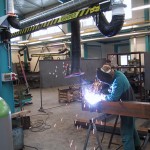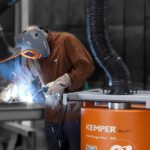Differences among filters and how to determine filter class
The filtration efficiency is classified into one of three welding fume filtration classes. High-grade steel alloys can be safely welded only with the right filter.
The welding fume filtration class—the so-called W-classes—let you read the filter performance on the label. The limit for respirable dusts that settle on the alveoli determines which filter performance is required. It depends on the material being welded as well as the welding process being used.
While the limit for breathable dust in the work area—which appears in a particle size of up to 100 microns—must be under 10 milligrams per cubic meter, the highest limit for respirable dust—at a size of up to 10 microns—must be under 1.25 milligrams per cubic meter. Companies must reduce ultrafine dust particles to a legal minimum, if they are not eradicated altogether. However, these unwanted nanoparticles, which appear in a size of less than one tenth of a micron, cannot be collected.
“Technical Regulations for Hazardous Substances – Air Return When Handling Carcinogenic Substances” (TRGS 560) is authoritative for welding fumes containing carcinogenic substances such as nickel oxide or chromium (VI) compounds. Welding fume extraction devices in Filtration Class W3 meet the requirements for purified air return in accordance with TRGC 560, as they were approved by the Insurance Institute for Occupational Safety (IFA) and grouped accordingly on a positive list.
The W Classes:
Testing of extraction devices takes place according to DIN EN ISO15012-1 “Occupational Health and Safety for Welding and Related Processes – Requirements, Testing and Labeling of Air Purification Systems – Part 1: Specifying Filtration Efficiency for Welding Fumes.” The classes can be summarized by the following characteristics:
Class W1
Filtration efficiency must be at least 95 percent or greater. Filters in this class are suitable for unalloyed or low-alloyed steel.
Class W2
Filtration efficiency greater than 98 percent: steel alloys with nickel and chromium components (5 to 30 percent composition) may be welded with this filter.
Class W3
Filters with a filtration efficiency greater than 99 percent: these filters must be used when working with high-alloy steel containing more than 30 percent nickel and chromium.





